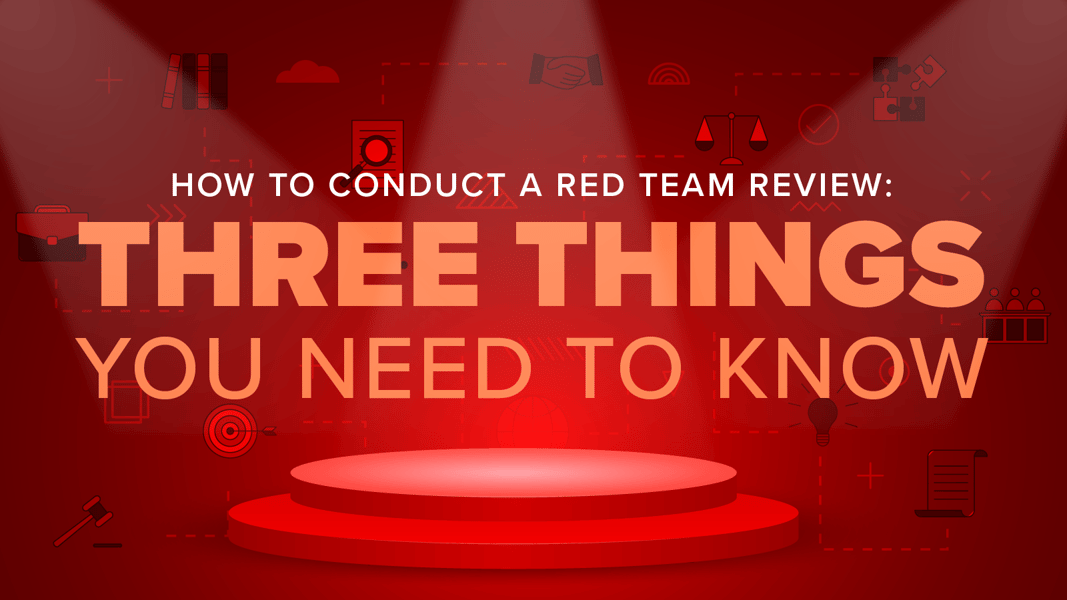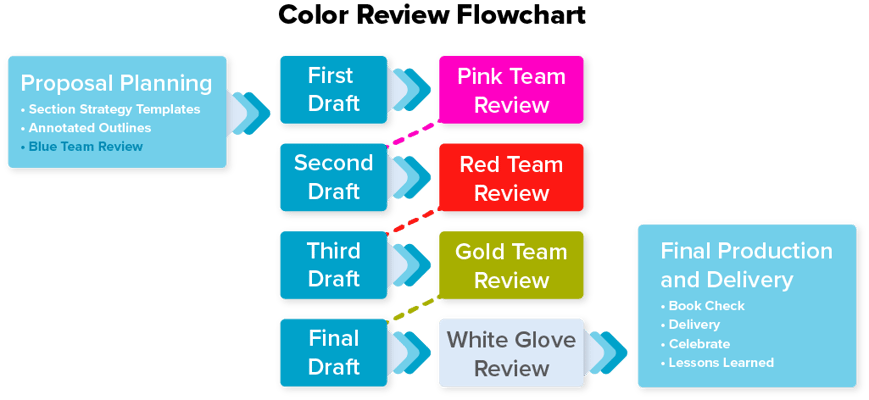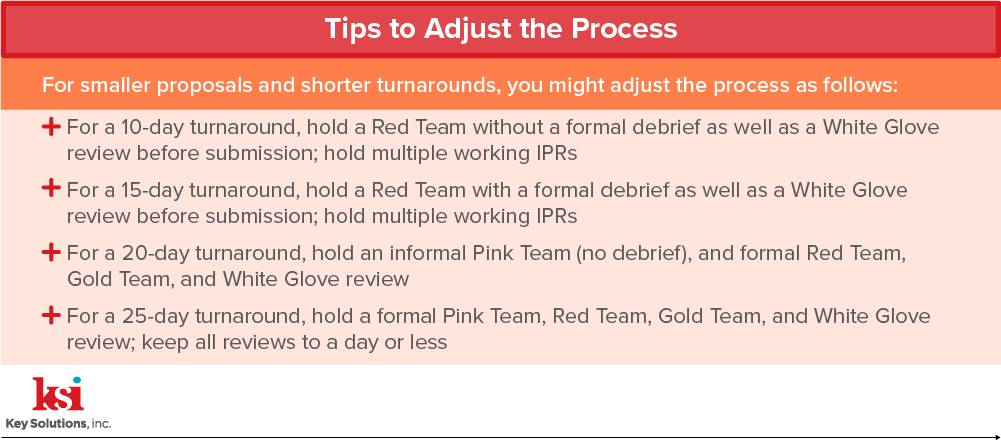
A Red Team Review is part of a series of color reviews that occur during the proposal development process.
In government proposals, the most commonly occurring color reviews are the Pink, Red, Gold, and White Glove reviews. Color reviews are designed to measure the level of development of your proposal response. These reviews usually occur in intervals and stages.

This article provides an overview of the Red Team Review and its importance in the proposal development process. In addition, we will share the best practices that will help you conduct a successful Red Team Review and lead to a higher-scoring proposal.
What is a Red Team Review?
The purpose of the Red Team is to review the mature proposal draft, usually conducted at about 80% to 95% completion.
Members of the Red Team are asked to set aside their personal preferences and approaches and to assume the independent role of a member of the Source Evaluation Board (SEB).
A Red Team Review aligns the various stages of proposal development with milestones that need to be achieved as the deadline approaches. In fact, it is good practice to map out high-level milestones, including color reviews, based on the submission deadlines. While some bids provide ample turnaround times, others need to be submitted within days. In either case, it is essential to perform a Red Team Review. Below find some tips that will come in handy when adjusting your Red Team Review process based on turnaround time.

1. Why Conducting a Red Team Review is Important
A Red Team member seeks to objectively examine and score the proposal document from the perspective of the customer. In addition, a good Red Team will not only score a draft proposal document but also provide the Proposal Team with constructive and actionable comments designed to upgrade the quality and responsiveness of the document.
According to the Association of Proposal Management Professionals (APMP), the Red Team can predict how well your proposal will score against the customer's evaluation criteria and recommend improvements.
The Red Team will be instructed to look for the following:
- Compliance: Verify that the material in the volumes responds to the requirements of the RFP
- Clarity: Ensure that the material presented is clear and complete
- Consistency: Ensure consistency throughout the proposal
- Accuracy: Ensure the information presented is correct in all respects
- Strategy: Provide input relative to strategic issues and win themes

A thorough review will help identify any remaining gaps post Pink Team Review, sections that need improvements or re-writes, and graphics that require changes; confirm key personnel candidates meet the requirements; and highlight key achievements throughout the response.
Red Team Reviews are not limited to just these areas of the response. In addition to reviewing these sections, it is essential to review any other volumes associated with the RFP response, such as a Security or Contracts Volume. A thorough review of these volumes may help eliminate erroneous data that could lead to disqualification.
Finally, performing a Red Team Review can provide a realistic overview of the progress of the response and guide the path forward into recovery and onto the Gold Team Review.
2. Tips for Conducting a Successful Red Team Review
Depending on the proposal delivery timeline, a review can be conducted in a variety of ways, such as virtually, in-person, or independently. The in-person model from pre-pandemic days enabled a team to gather in conference rooms and offices to read through, discuss, review, and adjust as needed based on real-time feedback received from colleagues sitting around the table. The COVID-19 pandemic and the subsequent long-term quarantine shifted the workplace model from in-person to virtual. The shift to a virtual work environment and the increased reliance on collaborative tools have equipped us to maintain team morale without sacrificing our health.
Ultimately, either in the real or virtual world, conducting a review is comprised of performing several different tasks that culminate in a review:

First and foremost, you must schedule the review. Plain and simple, our day revolves around our calendar. If the review is on the teams' calendar, then there is a good chance the proposal will be reviewed.
Second, identify the people who will be reviewing the response. This can include subject matter experts (SMEs), managers, subcontractors, partners, or other key stakeholders. These are the individuals who will provide the most constructive and concise feedback.
Next, it is very important to set expectations for the review and set guidelines during the proposal kickoff. This allows the reviewers to perform an in-depth and targeted review. I recommend you provide the following guidelines at a minimum:
- Check the response for compliance with the instructions, evaluations, and PWS requirements.
- Steer the team away from identifying insignificant formatting or grammar mistakes. This dilutes the task with an unnecessary step. Grammar and formatting can be handled as part of the editing/desktop publishing (DTP) process.
- Identify a flaw, gap, inconsistency, or error, and provide a solution to the identified issue. This can consist of helping isolate a source of information, helping fill in the blank, etc.
In addition to setting expectations, it is important to set up some type of scoring system for reviewers. This works best when assessed or scored in a similar manner as the evaluators. Essentially, the reviewers become the evaluators and provide their assessments. For more guidance on how to be a valuable reviewer to your team, check out this article.
Once the team has finished their review, a debrief will be conducted to discuss the feedback. This can take many shapes and forms. Most commonly, the reviewers provide an overview of their findings and possible fixes. Once all reviewers present their feedback, the next step becomes clear: the path forward. The path forward takes the issues identified during the review and rectifies them through the recovery.
3. Use Collaborative Tools to Streamline the Red Team Review
There are numerous types of tools and applications designed to create a collaborative environment in the cloud. Some of the most commonly used collaborative tools in our industry are Microsoft SharePoint and Google Docs.
These cloud environments allow teams to virtually interact and collaborate simultaneously on documents and presentations. These tools help track the status of the document, maintain version control, and enable multiple team members to work in the document simultaneously.The benefits of collaborative tools include:
- You can establish guidelines to access the document as well as lock-out periods.
- You can review changes, updates, and comments in near real-time.
- You can have multiple reviewers evaluate and provide comments in the same document simultaneously.
- The fluidity of changes and multiple versions can make it difficult to revert back to a previous version of the document if needed.
- Writers may want to start recovery before all reviewers have finished their review; communicating clear instructions about document access and review timelines is critical.
- Reviewers may be compelled to continue editing after the review period; if you allow this, it is important to establish clear parameters and controls.
Conclusion
The Red Team Review is critical to a successful proposal effort because it enables the team to gauge the consistency, clarity, compliance, strategy, and accuracy of the proposal response. A thorough review will help identify any compliance issues, remaining gaps, sections that need improvements or re-writes, and graphics that require changes, as well as verify that key achievements are highlighted throughout the response.
Need color review support? Book a KSI team member through our On-Demand Services.








